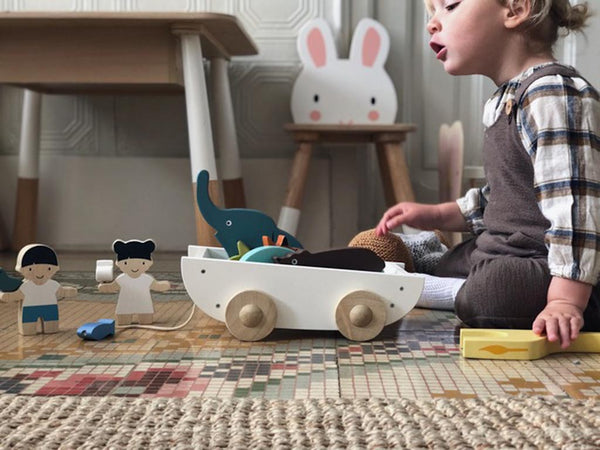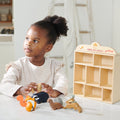What is open-ended play and why is it so special?

Open-ended play is at the heart of early years learning.
You don't need expensive or hard-to-find toys. There are no instructions.
The learning curve is as steep or as gentle as you want it to be. You can go at your own pace and - best of all - the challenge increases as you skill levels improve.
Open-ended play is play at its most pure. Let's take a look at how to get more of it.
Table of contents
- Closed-ended play is good
- Open-ended play is better
- What are the best open-ended toys?
- Final word
Closed-ended play is good
What can you do with a puzzle? Or a shape sorter? Or a maze?
Only one thing: complete it.
There’s only one path to the finish.
Sure, you can make mistakes along the way but, ultimately, it’s the same every time you play.
The ending is closed.
Closed-ended toys get a bad press because of their more celebrated, open-ended counterparts.
But closed-ended toys are good. A puzzle or shape sorter demand good fine motor control and the spatial reasoning to envisage how a shape will fit into a space without first trying it.
They also encourage focus and perseverance. Puzzles can be frustrating if you make a mistake and have to unpick several pieces. Do you have the grit to start again and follow through to the finish?

This plant puzzle is classic closed-ended toy. It's great fun to complete and develops all kinds of vital skills but there is really only one way to make it. Puzzles are an essential component of any well-balanced toy box but the mix should be weighted towards open-ended materials.
What is open-ended play?
What makes sticks and stones such brilliant play materials? What’s so special about string and play dough?
It’s not what they are made of - it’s what you can do with them.
Sit down in front of a block of clay and the direction you take is only limited by your creativity.
The material is open-ended.
Open-ended toys ask questions. There’s no ‘right’ way to use them.
Why is open-ended play important?
Using open-ended materials forces you to make choices.
What will I make? How will I make it? How big will it be? How will I know when I have finished?
It also forces you to confront uncertainty and the possibility that it might all go wrong. How will you react? Will you start again with calm acceptance and persevere until the end?
In short, open-ended play encourages problem solving and creativity - essential higher-order thinking skills.

The best open-ended toys
-
Wooden figures
Once upon a time…
Take a wooden figure in your hand and you immediately have a story. What will he do? Who will he meet? The story can go anywhere. It’s the most open-ended kind of play there is.
The figures don’t have to be human. Many children’s stories feature animals and your child’s play will be no different. And because we associate certain characteristics with each animal, plot lines naturally suggest themselves: a fox and some chickens can only mean one thing; or a cat and a mouse.
To learn more about this kind of play, see our article on small world play.
-
Dolls
How many stories can you tell with a doll? What adventures could she have? You could tend to her in her sickbed, take her to the shops, invite her to tea or imagine that she is a sleeping princess waiting for love’s first kiss.
-
Loose parts
Loose parts are nothing more than bits and pieces you have lying around the home. They could be buttons, cotton reels or marbles. Or, sticks, stones and pine cones.
The essential point is that you have many. Roll them, stack them, pour them, line them up. It doesn’t matter. What makes them special is their simple nature. They can be anything you want them to be.
-
Wooden blocks
Blocks are the original open-ended toy. Build, transport, arrange, count and create - there’s not much you can’t do with a set of blocks.
-
Wooden train sets
A simple loop of track doesn’t seem particularly open-ended. The trains go round and around. Always the same route and the same result.
The layout can be changed, which helps, but the secret of a wooden railway lies in the storytelling possibilities. You only have to watch a few episodes of Thomas the Tank Engine to realise how many potential directions a child’s play can take.
Try introducing other materials to your train set to extend the learning. What could your child create if you added pencils, paper and tape? Or cereal boxes and scissors? How could a strip of fabric be incorporated or collection of pine cones and conkers?
-
Play food
Breakfast for a king, Grandma’s birthday or a teddy bears' picnic - play food can be served on almost any occasion.
See wooden play food.
-
Doll's house
What happens in your doll’s house? Who lives there? What do they do? Do they all get on?
And who comes to visit? And what adventures do they have?
The story-telling potential is limitless - like life itself.
-
Bags, baskets and trolleys
If you’ll pardon the pun, is there anything more open-ended than a basket?
What can you put in there? Where will you take it? What will you do once you get there?
Take a cake to Grandma (avoiding the Big Bad Wolf along the way)? Collect acorns from beneath the oak?
And what of your trolley? Will you transport blocks or dolls or something else?
The simplest toys are the best - but they are not always the most obvious. Take another look at these transporting ‘toys’. You’ll get years of play out of them.
See baskets, trolleys and walkers.
Final word
Open-ended play is supposed to go wrong.
That’s where the learning happens.
Let your child make mistakes and don’t offer corrections. Working out the answer yourself is a powerful mechanism for extending thought.
When you do help, instead of fixing things, ask a question instead.
Why do you think it broke?
What would you do differently next time?
Can you think of something in the room that would stand in for the missing piece?
Open-ended play is about teaching children to think for themselves - and it does so brilliantly.











